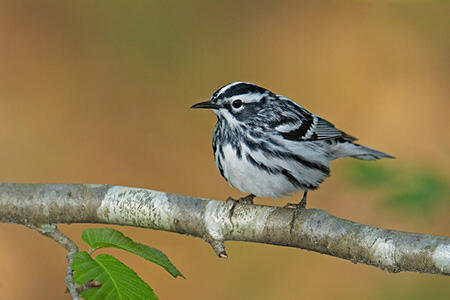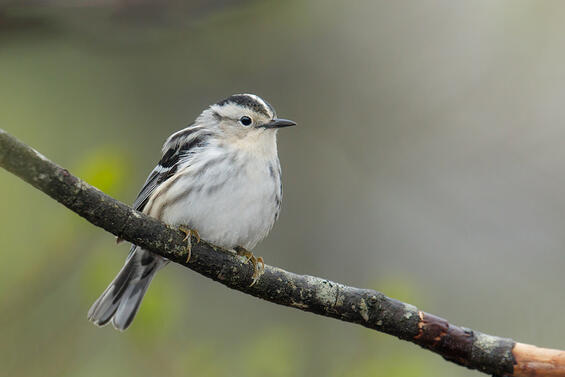- Scientific name: Mniotilta varia
Species of Greatest Conservation Need (MA State Wildlife Action Plan)
Description

Black-and-white warbler (Mniotilta varia)
The black-and-white warbler is a long-distance migrant songbird with a unique black and white striped plumage. The adult male has more black coloration in the face, throat, and streaking on the underparts than the female or juveniles. It is one of the first warblers to return in spring and can easily be identified by its song, which is often likened to the sound of a squeaky wheelbarrel. Black-and-white warblers forage along tree trunks and limbs as they search for arthropods, a strategy unique among wood warblers, but similar to the brown creeper or white-breasted nuthatch.
Life cycle and behavior
The black-and-white warbler arrives in Massachusetts in late April to early May to establish breeding territories in mature and mixed forests. Males sing persistently to defend territories, and pairs form monogamous bonds during the breeding season. Nests are built on the ground in a shallow depression at the base of trees or stumps, concealed by leaf litter. Females lay 3–6 eggs, which they incubate for about 10–12 days. Both parents contribute to feeding the nestlings, which fledge after 8–12 days. Following the breeding season, black-and-white warblers undergo a molt before migrating south to their wintering grounds. During migration, they utilize a variety of forested habitats, often stopping to forage on tree trunks and limbs, a feeding behavior unique among warblers.

Population status
Although the black-and-white warbler is not listed in the Massachusetts Endangered Species Act, according to the Breeding Bird Survey, this species has undergone a -0.7% and a -2.3% annual decline range-wide and in Massachusetts, respectively. The Massachusetts Breeding Bird Atlas indicates that this species remains common in the heavily forested regions of western and central portions of the state, but that a decline is evident throughout much of eastern Massachusetts.

Black-and-white warbler (Mniotilta varia)
Distribution and abundance
The black-and-white warbler has a large breeding range that extends across most of the deciduous forest of eastern North America and includes much of the boreal forest extending into western Canada. Similarly, they have a large overwintering range that includes northern South America, Central America, the Caribbean Islands, Mexico, and parts of the southernmost United States.
Habitat
Black-and-white warblers nest in hardwood and mixed coniferous-hardwood forests across a range of ages from relatively young (10-20 years post-disturbance) to old-growth forests. This species also can nest in a range of moisture conditions from wetland areas to dry hillsides. As is the case with many warblers, black-and-white warblers nest on the ground, often in a depression at the base of a tree or stump. This species is considered to be area-sensitive and generally absent from forest patches less than 10 hectares (25 acres) in size.
Healthy habitats are vital for supporting native wildlife and plants. Explore habitats and learn about conservation and restoration in Massachusetts.
Threats
The main threat to this species is thought to be habitat loss, degradation, and fragmentation on both the breeding and wintering grounds. As a result of its sensitivity to patch size, the disappearance of this species from heavily fragmented habitats is well documented. Black-and-white warblers may be particularly vulnerable to habitat fragmentation in urban, suburban, or rural landscapes. Such areas often have an inflated nest predator community, including domestic cats, raccoons, and skunks, which take a high toll on the eggs and young of ground-nesting birds. Another major threat facing this species is collision with manmade structures like windows, buildings, towers, and wind turbines.
An additional threat to the species is collisions with buildings and other structures, as approximately 1 billion birds in the United States are estimated to die annually from building collisions. A high percentage of these collisions occur during the migratory periods when birds fly long distances between their wintering and breeding grounds. Light pollution exacerbates this threat for nocturnal migrants as it can disrupt their navigational capabilities and lure them into urban areas, increasing the risk of collisions or exhaustion from circling lit structures or areas.
Predation by domestic cats has been identified as the largest source of mortality for wild birds in the United States with the number of estimated mortalities exceeding 2 billion annually. Cats are especially a threat to those species that nest on or near the ground.
Conservation
Habitat conservation efforts should focus on protecting and maintaining large, contiguous tracts of mixed hardwood forests. Conservation easements and sustainable forestry practices can help mitigate habitat loss, while restoring forest connectivity through reforestation efforts can benefit area-sensitive species like the black-and-white warbler.
Nest predation can be minimized by maintaining understory vegetation and reducing human disturbance in known breeding areas. Promote responsible pet ownership that supports wildlife and pet health by keeping cats indoors and encouraging others to follow guidelines found at fishwildlife.org.
Bird collision mortalities can be minimized by making glass more visible to birds. This includes using bird-safe glass in new construction and retrofitting existing glass (e.g., screens, window decals) to make it bird-friendly and reducing artificial lighting around buildings (e.g., Lights Out Programs, utilizing down shielding lights) that attract birds during their nocturnal migration.
References
Kricher, J. C. (2020). Black-and-white Warbler (Mniotilta varia), version 1.0. In Birds of the World (A. F. Poole, Editor). Cornell Lab of Ornithology, Ithaca, NY, USA. https://doi.org/10.2173/bow.bawwar.01
Walsh, J., and W.R. Petersen. 2013. Massachusetts Breeding Bird Atlas 2. Massachusetts Audubon Society and Scott & Nix, Inc.
Mass Audubon. “Black-and-white Warbler.” Mass Audubon Breeding Bird Atlases. Accessed March 17, 2025.
American Bird Conservancy. “Black-and-white Warbler.” Accessed March 17, 2025.
Animalia. “Black-and-white Warbler.” Animalia.bio. Accessed March 17, 2025.
Contact
| Date published: | May 14, 2025 |
|---|